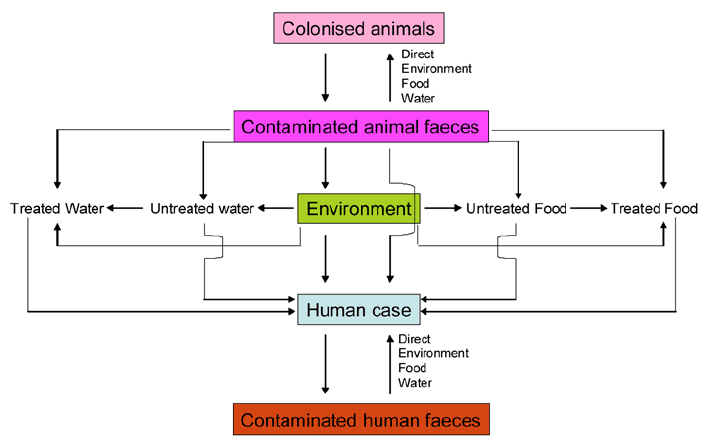VTEC/E. coli O157 Action Plan for Scotland, 2013-2017
An Action Plan setting out recommendations to tackle the transmission of VTEC/E. coli O157 infection.
V. LOGICAL FRAMEWORK OF THE PLAN
For a human case of VTEC infection to occur, the organism must have a source, a pathway of transmission, and a receptor to be infected. Pathways from colonised animals to the human case are summarised in Figure 2. 'Colonisation' or 'contamination' in this document refers to VTEC colonisation or contamination unless stated otherwise.

In this Action Plan, the source of VTEC infection is deemed to be the colonised animal, even though the colonised animal must have become colonised via its food, drinking water, environment, or the faeces of another colonised animal. Human cases can be avoided by removing the source or interrupting a step in the pathway. It is important that current legislation and guidance is followed by those to whom it is addressed, and that the VTEC Action Group is alert to new developments which might inform future guidance. The Action Plan does not describe the control measures applicable to such steps in detail but concentrates on steps where new action is realistic and may minimise risk of illness. An absence of new recommendations means that no new actions were identified. The section on Research addresses areas where new knowledge might inform new actions, but where evidence is currently insufficient for firm recommendations.
The chapters of this Action Plan therefore:
- Describe the step in the pathway being addressed (shown in red on each chapter's graphic).
- Summarise (briefly where the current position is satisfactory, or not amenable to change) the current position, and make recommendations if appropriate, for:
− New control measures.
− New monitoring of compliance with control measures.
− New evaluation of effectiveness of appropriately applied new control measures. - Describe in general terms the issues relevant to communication and health education which the Scottish Government should address in its communications strategy.
- Describe in general terms the issues relevant to research which the Scottish Government should address in its research strategy.
The ultimate measure of the effectiveness of control measures for VTEC is a reduction in the number of human cases but, as the drivers of infection are many and complex, changes in case numbers could not be attributed to any one intervention. For this reason, we do not propose that the number of cases reported to national surveillance in Scotland should be used as a measure of effectiveness.
It is also possible that there is an irreducible minimum number of cases despite the effective application of control measures. It is still important that every effort is made to implement all current and newly recommended control measures.
Contact
Email: Jeanna.Sandilands@gov.scot
There is a problem
Thanks for your feedback